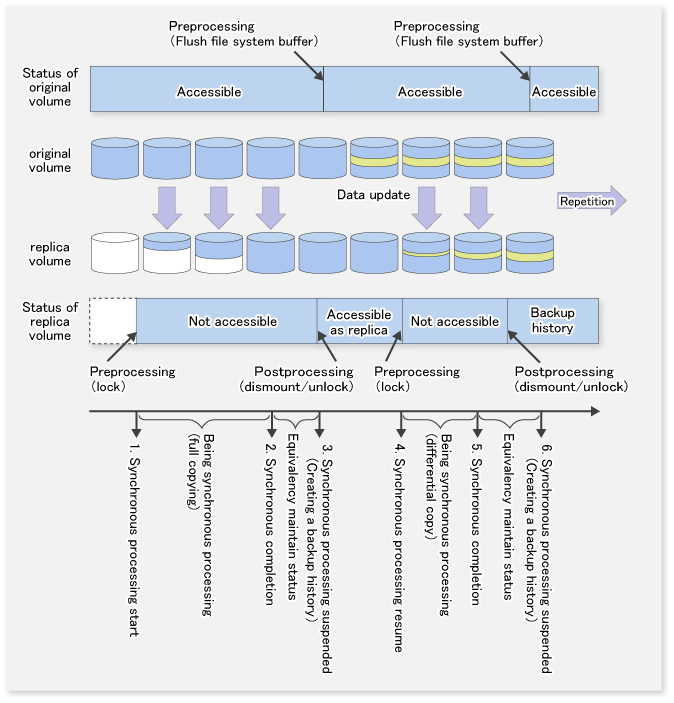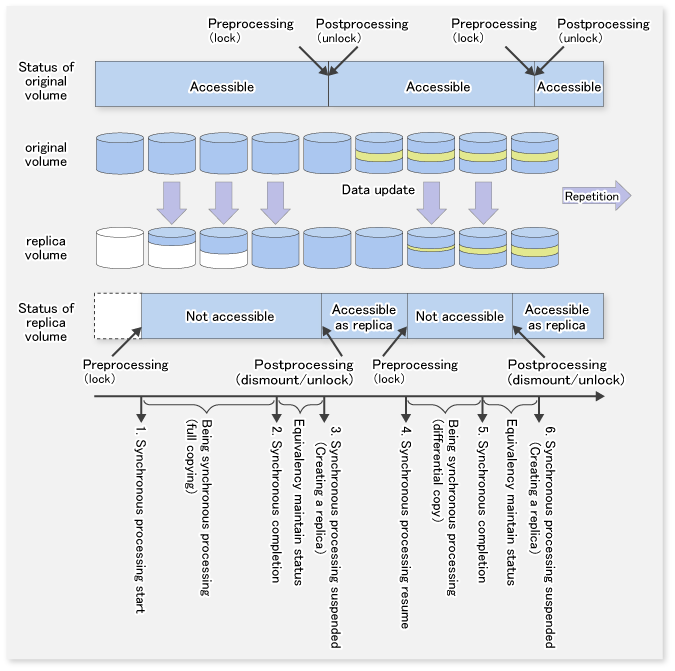Pre-processing and post-processing for a replication source volume are performed to guarantee a replication destination volume.
Pre-processing and post-processing for a replication destination volume is performed to prevent other processes from accessing to the volume during synchronization processing or snapshot copy.
If the replication source and destination volumes are partitions, it is assumed that a file system has been constructed on the volumes and the following pre-processing and post-processing are performed.
Target | Type | Details |
|---|---|---|
Replication source volume | Pre-processing |
|
Post-processing |
| |
Replication destination volume | Pre-processing |
|
Post-processing |
|
If the replication source volume and the replication destination volume are Logical Units (disks), the following pre-processing and post-processing are performed.
Target | Type | Details |
|---|---|---|
Replication source volume | Pre-processing |
|
Post-processing |
| |
Replication destination volume | Pre-processing |
|
Post-processing |
|
The implementation status of the pre-processing and post-processing for a file system is shown below.
This table shows whether pre-processing and post-processing are performed depending on the command type. It also shows the copy status at the time of the command execution.
Command | Copy status | Source/Destination | Pre-processing | Post-processing |
|---|---|---|---|---|
Copy not started, or replication establishment | Source | X | X | |
Destination | O--*1 | H--*2 | ||
Equivalency maintenance | Source | O | O | |
Destination | H--*1 | O--*2 | ||
Equivalency maintenance | Source | O | O | |
Destination | H--*1 | O--*2 | ||
Replication establishment | Source | X | X | |
Destination | X | X | ||
Copying | Source | X | X | |
Destination | X | H--*2 | ||
Copy not started | Source | O | O | |
Destination | O | O |
O: Executed
H: Indicates execution when the destination volume is a shared volume in a clustered system (note, however, that no call is made to the destination post-processing script).
X: Not executed
The post-processing for the pre-processing executed in step (*1) is executed in step (*2).
The pre-processing and post-processing for a file system can be customized. The processing is started in accordance with the table above when a replication management command is executed. For replication between servers, these scripts are executed by remote execution using TCP/IP in the pre-processing and post-processing of a volume that is not connected.
The operation image before and after processing is shown in the following figure.
Figure C.1 Synchronized replication processing (flushing the file system buffer of replication source volume)

Figure C.2 Synchronized replication processing (locking the replication source volume)

If processing other than the standard pre-processing and post-processing is required in the pre-processing and post-processing, customize the scripts.
When customizing a script, strictly observe the following rules regarding error codes:
Error code | Usage |
|---|---|
0-99 | Unusable (reserved for AdvancedCopy Manager) |
100-255 | Usable |
Note
AdvancedCopy Manager provides pre-processing and post-processing for Oracle, SQL Server, Exchange and Hyper-V applications. In case of using any other application than these, if needed, pre-processing and post-processing must be executed uniquely before and after (respectively) the execution of the AdvancedCopy Manager command.